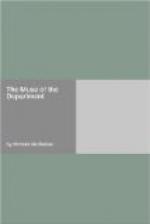Sancerre, the pride of the left bank, numbers three thousand five hundred inhabitants at most, while at Cosne there are now more than six thousand. Within half a century the part played by these two towns standing opposite each other has been reversed. The advantage of situation, however, remains with the historic town, whence the view on every side is perfectly enchanting, where the air is deliciously pure, the vegetation splendid, and the residents, in harmony with nature, are friendly souls, good fellows, and devoid of Puritanism, though two-thirds of the population are Calvinists. Under such conditions, though there are the usual disadvantages of life in a small town, and each one lives under the officious eye which makes private life almost a public concern, on the other hand, the spirit of township—a sort of patriotism, which cannot indeed take the place of a love of home —flourishes triumphantly.
Thus the town of Sancerre is exceedingly proud of having given birth to one of the glories of modern medicine, Horace Bianchon, and to an author of secondary rank, Etienne Lousteau, one of our most successful journalists. The district included under the municipality of Sancerre, distressed at finding itself practically ruled by seven or eight large landowners, the wire-pullers of the elections, tried to shake off the electoral yoke of a creed which had reduced it to a rotten borough. This little conspiracy, plotted by a handful of men whose vanity was provoked, failed through the jealousy which the elevation of one of them, as the inevitable result, roused in the breasts of the others. This result showed the radical defect of the scheme, and the remedy then suggested was to rally round a champion at the next election, in the person of one of the two men who so gloriously represented Sancerre in Paris circles.
This idea was extraordinarily advanced for the provinces, for since 1830 the nomination of parochial dignitaries has increased so greatly that real statesmen are becoming rare indeed in the lower chamber.
In point of fact, this plan, of very doubtful outcome, was hatched in the brain of the Superior Woman of the borough, dux femina fasti, but with a view to personal interest. This idea was so widely rooted in this lady’s past life, and so entirely comprehended her future prospects, that it can scarcely be understood without some sketch of her antecedent career.
Sancerre at that time could boast of a Superior Woman, long misprized indeed, but now, about 1836, enjoying a pretty extensive local reputation. This, too, was the period at which two Sancerrois in Paris were attaining, each in his own line, to the highest degree of glory for one, and of fashion for the other. Etienne Lousteau, a writer in reviews, signed his name to contributions to a paper that had eight thousand subscribers; and Bianchon, already chief physician to a hospital, Officer of the Legion of Honor, and member of the Academy of Sciences, had just been made a professor.




